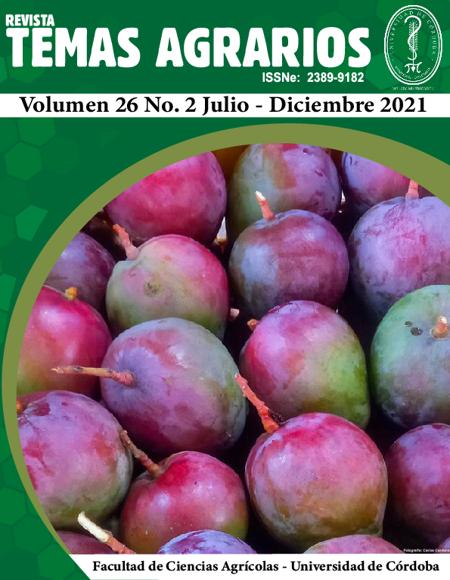Sensoramiento remoto del rendimiento agrícola en caña de azúcar en Cacocum, Cuba
Remote sensing of crop yield sugarcane in Cacocum, Cuba.

Esta obra está bajo una licencia internacional Creative Commons Atribución-NoComercial 4.0.
Mostrar biografía de los autores
El estudio se realizó en el año 2021 con el objetivo de estimar el rendimiento agrícola de la caña de azúcar mediante el Índice de Diferencia Normalizado de Vegetación en la Empresa Azucarera “Cristino Naranjo”, ubicado en el municipio Cacocum provincia Holguín, Cuba. Se trazaron 32 puntos aleatorios de muestreo en los diferentes meses en los que se escogieron las imágenes pertenecientes al satélite Landsat 8 OLI/TIRS proyectadas en el sistema WGS 84 UTM Zona 18 Norte en la cuadrícula 011/046. En el software QGIS “A Coruña” versión 3.10 se realizó la corrección radiométrica de cada imagen satelital y el esquema de muestreo, mientras que en ArcGIS 10.5 se realizó la extracción de los valores de cada punto luego del cálculo del NDVI Para el procesamiento estadístico se utilizó el software Stargraphics Plus 5.0; en el cual se realizó el análisis de regresión lineal entre los valores obtenidos del NDVI en cada punto de muestreo y los valores del rendimiento real ofrecidos por especialistas del área de análisis del Central que se corresponden a las fechas de las imágenes utilizadas. La determinación del índice vegetativo NDVI muestra valores desde 0 hasta 0,5 se presenta una escasa vegetación en el área de estudio. El coeficiente de determinación indica que el modelo explica el 97,8598 de la variabilidad del rendimiento en el cultivo de la caña de azúcar lo cual puede ser utilizado como modelos matemáticos para la estimación del rendimiento de este cultivo bajo las condiciones edafoclimáticas del sitio de estudio.
Visitas del artículo 543 | Visitas PDF
Descargas
- Aguilar, N., Galindo, G., Fortanelli, J. and Contreras, C. 2010. Índice normalizado de vegetación en caña de azúcar en la Huasteca Potosina Avances en Investigación Agropecuaria 14(2):49-65
- Awad, M. 2019. Toward precision in crop yield estimation using remote sensing and optimization techniques. Agriculture 9(54):1-13.
- Bocco, M., Sayago, S. and Willington, E. 2014. Neural network and crop residue index multiband models for estimating crop residue cover from Landsat TM and ETM+ images. International Journal of Remote Sensing 35(10): 3651-3663.
- Dancé, J. y Sáenz, D. 2016. La cosecha de caña de azúcar: impacto económico, social y ambiental. Dirección de Investigación FCCEF-USMP, Perú, p1-18.
- Food and Agriculture Organization of the United Nations. 2017. Food and Agriculture Data (FAOSTAT). Food and Agriculture Organization of the United Nations, Rome, Italy, p48.
- Fortes, C. 2006. Discrimination of sugarcane varieties using Landsat 7 ETM+ spectral data. International Journal of Remote Sensing 27(7): 395-412.
- García, R., Villazón, J., Morales, A. y Velázquez, E. 2019. Efecto de la cosecha mecanizada sobre la variabilidad espacial de la resistencia a la penetración. Revista Ingeniería Agrícola, 9(2): 45-50.
- Gilabert, M.A., González, P.J. y García, H.J. 1997. Acerca de los índices de vegetación. Revista de Teledetección 8(1): 1-10.
- Hernández, A., Pérez, J. y Rivero, L. D. 2015. Nueva versión de clasificación genética de suelos de Cuba. AGRINFOR, La Habana, Cuba, p91.
- Krishna, R. P. 2002. Remote sensing: a technology for assessment of sugarcane crop acreage and yield. Sugar Tech 4(3):97-101.
- Li, A., Liang, S., Wang, A. and Qin, J. 2007. Estimating crop cield from Multi-temporal satellite data using multivariate regression and neural network techniques. Photogrammetric Engineering and Remote Sensing 73(10): 1149-1157.
- Meera, G.G., Parthiban, S., Thummalu, N. and Christy, A. 2015. Ndvi: Vegetation change detection using remote sensing and gis–A case study of Vellore District. Procedia Computer Science 57: 1199-1210.
- Molijn, R., Iannini, L., Vieira, J. and Hanssen, R. 2019. Sugarcane productivity mapping through C-Band and L-Band SAR and Optical Satellite Imagery, Remote Sensing, 11(1109): 1-27.
- Pandey, S., Patel, N. R., Danodia, A. and Singh, R. 2019. Discrimination of sugarcane crop and cane yield estimation using landsat and irs resourcesat satellite data. The International Archives of the Photogrammetry, Remote Sensing and Spatial Information Sciences 62-3/W6: 229-233.
- Rawashdeh, S. 2012. Assessment of change detection method based on normalized vegetation index in environmental studies. Internatinal Journal of Applied Science and Engineering, 10(2): 89-97.
- Rouse, J., Haas, R., Schell, J. and Deering, D. 1974. Monitoring Vegetation Systems in the Great Plains with ERTS Proceeding. En: Third Earth Reserves Technology Satellite Symposium, Greenbelt: NASA SP-351, USA.
- Singh, K., Sunila, G. and Kumar, S. 2020. Crop Yield Prediction Techniques using Remote Sensing Data. International Journal of Engineering and Advanced Technology 9(3): 3683- 3689.
- Stas, M., Orshovn, J.V., Dong, Q., Heremans, S. and Zhang, B. 2016. A Comparison of machine learning algorithm for regional wheat yield prediction using NDVI time series of SOPT-VGT”, IEEE International Conference Agro-Geoinformatics,pp1 -5.
- United State of Geological Survey. 2021. Landsat Earth observation satellites: U.S. Geological Survey Fact Sheet 2015-3081.
- Virnodkar, S., Pachghare, V., Patil, V. and Kumar, S. 2020. Remote sensing and machine learning for crop water stress determination in various crops: a critical review. Precision Agriculture. https://doi.org/10.1007/s11119-020-09711-9
- Zenteno, G., Palacios, E., Tijerina, L. y Flores, H. 2017. Aplicación de tecnologías de percepción remota para la estimación del rendimiento en caña de azúcar. Revista Mexicana de Ciencias Agrícolas, 8(7): 1575-1586.




















